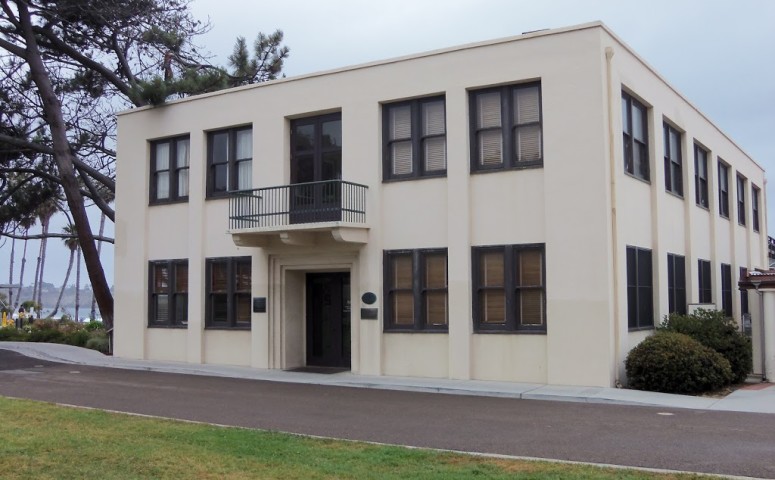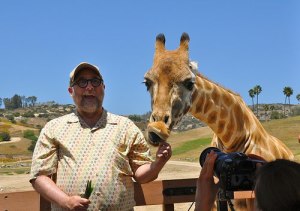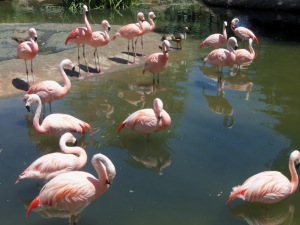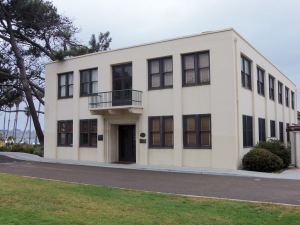 |
| The Scripps Lab Architect: Irving Gill |
La Jolla Shores Beach
There are few houses right on the beach at La Jolla Shores, just north of the village. They tend to be large and nondescript. It’s not a community full of those “my architect is more famous than your architect” houses that you find in Malibu. Nobody is bothered too much with style. This is odd, given that it could be argued that American modernism was born and dramatically furthered here in La Jolla.
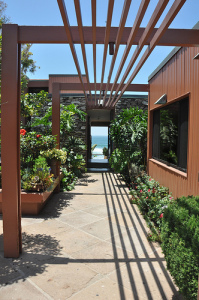 |
| Our modern beach house for a week Photo: Connie Poor |
Our good friends David and Cherie rented the best of these large houses for a week to celebrate a milestone birthday. The arrangement of volumes was like a modernist puzzle, while the décor was faintly baroque. Most importantly, every room faced the ocean. I can’t remember when I last slept so well. Our constant companions (and entertainment) were the surfers, who never crashed into each other despite their numbers. They would shoot inside the water tunnel and fly over the top of the cresting wave to ride the backside. Invariably, we put our novels down to watch the neoprene-clad dancers wait and then suddenly cast their fate to the curl. Of course, the coup de grâce was when they pulled off their rubber skins.
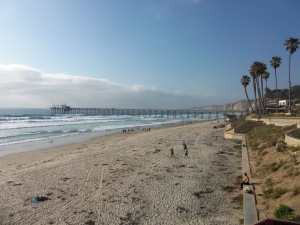 |
| Our view of the surfers |
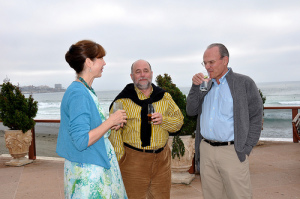 |
| The hosts with your loyal correspondent Photo: Connie Poor |
La Jolla Village/Gill’s Corner
The best parts of the village are the coves where the seals have taken up physical and olfactory space. Up the hill is the landmark pink hotel, La Valencia, and what perhaps was the center of early American modernism, a neighborhood full of the works of Irving Gill.
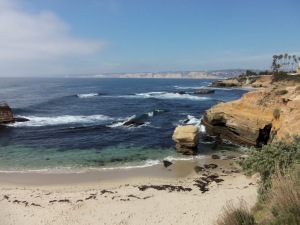 |
| The cove now taken over by seals |
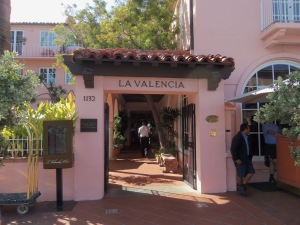 |
| La Valencia |
San Diego has a touch of the Texas. By that I mean questionable zoning practices.… One highrise right on the ocean in the village is the kind of carbuncle that Prince Charles goes on about. I assume it was built before the coastal initiative. No detail, no materials, no grace, wrong scale. Should be removed. There are still a number of historic buildings, but most of the contemporary buildings could be anywhere suburbia.
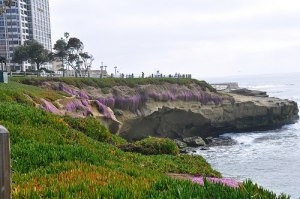 |
| Carbuncle at the shore Photo: Connie Poor |
However, around the intersection of Prospect, Silverado, and Draper Streets is the heart of America’s own modernism. Known mostly to the cognoscenti, Irving Gill was one of the country’s architectural pioneers. Practicing at the same time as the Viennese Adolph Loos (Esther McCoy would argue that he was already practicing before Loos), he was creating a new architecture that paid attention to tradition and the vernacular but was built for the 20th century. He made concrete humane.
His lessons still hold. He very nearly shaped an entire precinct with his work for the Bishop’s School and his patron, Ellen Browning Scripps. (Gill designed the original building for the Scripps Institution of Oceanography a mile or so up the coast. That building still stands, although the west façade has been somewhat obscured by later construction.)
Gill’s largest commission was the Bishop’s School (1910-1916), which Scripps underwrote. A nostalgic spire designed by Carleton Winslow, who had worked for Bertram Goodhue, replaced his original tower. Unfortunately, the complex is nearly impenetrable from the street. During this period, Scripps also commissioned the La Jolla Woman’s Club, which can be seen easily from the street and is a popular destination for weddings and other social events. The columns that hold up the arcade have inspired several other buildings, including the nearby Brooks Brothers retail building by ELS.
The Woman’s Club was one of the first buildings built with tilt-slab construction. The same method was used across the street at the Scripps Recreation Center. This public building shows the wear and tear of public maintenance and is currently painted pink. But at least it still stands. Next door to the Woman’s Club is the Kautz Residence, which is now a bed and breakfast. Across the way is Ellen Scripps’s own residence, which has been engulfed by Robert Venturi’s Contemporary Art Museum. There are more beautiful examples of Gill’s work throughout San Diego and Los Angeles, and one beautiful complex in Piedmont is attributed to him. His story is tragic, but his accomplishment is immense.
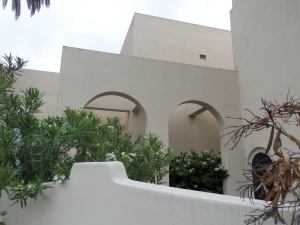 |
| Bishop School detail Architect: Irving Gill |
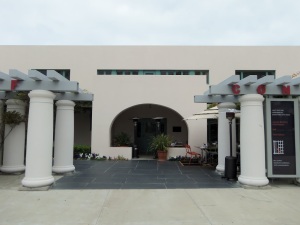 |
| Ellen B. Scripps residence surrounded by Robert Venturi |
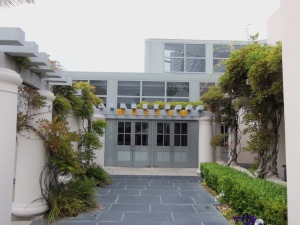 |
| Ellen B. Scripps residence surrounded by Robert Venturi |
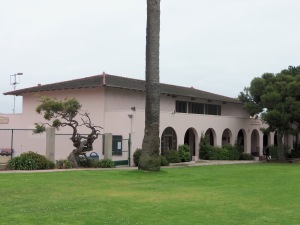 |
| La Jolla Recreation Center Architect: Irving Gill |
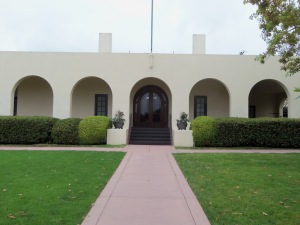 |
| La Jolla Woman’s Club Architect: Irving Gill |
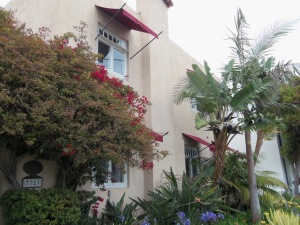 |
| Kautz Residence now a bed and breakfast Architect: Irving Gill |
http://www.sandiegohistory.org/online_resources/gill.html
http://www.amazon.com/Irving-Gill-Architecture-Reform-Architectural/dp/1580930166
Safari Park
I was worried that the Safari Park would be like Disneyland. And while there are Disney touches (Land Rovers parked in the trees?), the park is beautifully landscaped and goes to great lengths to educate the public about the animals. Our hosts treated us to a photo safari. We got on a truck (with a canopy, thank God) and drove out into the savannah to see the giraffes, rhinos, and impalas in something close to their natural habitat.
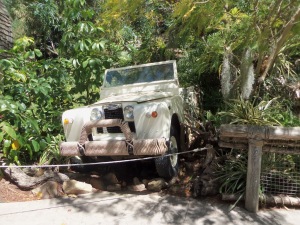 |
| Disney-like display at Safari Park |
The giraffe’s tongue was the longest I’ve ever seen. The beast can find your food and reach its tongue out several feet to get it. But the color of the tongue was not, as I imagined, a range of pinks, reds, and maroons—instead, it was the ugliest grey, like a slug. But those beasts do have the prettiest eyelashes. When they lean over to drink water, they can’t get oxygen. Just before they appear to pass out, they swing their long necks into the air and fill their lungs. Although enormous, the rhinos were quite gentle. In a photo, their hides look like metal plates, but in person they are suppler, bending and creasing as they waddle along.
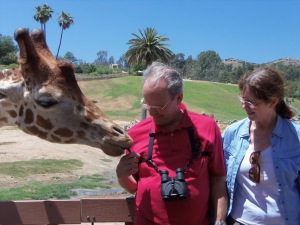 |
| The giraffe nibbles at our hosts at Safari Park |
 |
| The gentle rhinos come in for a snack |
Salk Institute
For architecture junkies, Salk is a kind of Mecca. For agnostics (about God or concrete), the place can also make you a believer. The genius of the place is that the architect integrates the ineffable and the real. Spirit and science. Space and concrete. Infinity and walls. We were lucky to get Ellen Zimmerman as our guide. She talked about Kahn as an existential architect and spoke of his masterwork in philosophical terms. Although we didn’t get to see the private offices, we did see the library and an interstitial floor. Vierendeel trusses and the full-height interstitial floors allow the lab floors to be completely flexible. This was one of the highlights of the year so far. If you go, be sure to book a tour in advance.
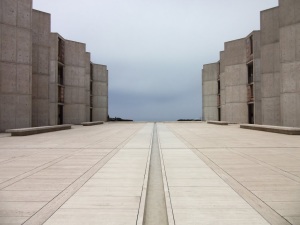 |
| The ethereal and very real Salk Institute |
http://www.salk.edu/about/architecture_tours.html
http://en.wikipedia.org/wiki/File:Salk_Institute_outline_of_laboratory_floor_and_Vierendeel_truss.jpg
UC San Diego
Built in the second half of the 20th century, UC San Diego is a modern campus that will take a few years to explore. That’s a good thing, because my niece Jaclyn starts school there in the fall. We explored her college, Eleanor Roosevelt, designed by Moshe Safdie and opened in 2003. It’s an interesting experiment in the scale of outdoor space. The buildings on the west side of the road are much more inviting because of the scale of the courtyards and the landscape. The east complex has few plants, and the courtyard doesn’t feel quite right. Hopefully, my niece will get an ocean view room! Then she will also have a fine vista of the Salk Institute.
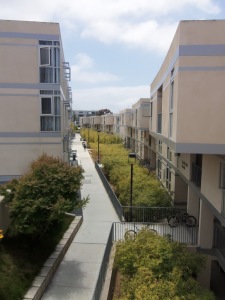 |
| Eleanor Roosevelt College Architect: Moshe Safdie |
The other goal of this visit was to see Mandeville Hall by A. Quincy Jones. It was one of the few buildings of his in California that I hadn’t seen. It is a tough building, but given that it was designed to house visual arts and music students, it had to be tough. (The art students are probably a tougher lot.) The concrete work doesn’t compare to Salk. But I doubt the construction or maintenance budget did either! His building altered Robert Alexander’s master plan forever, blocking his grand axis and resulting in a more meandering pedestrian experience.
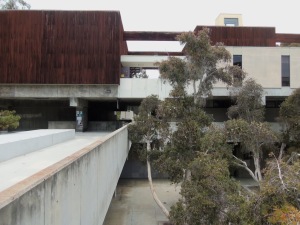 |
| Mandeville Arts Center Architect: A. Quincy Jones |
We were also lucky to see Robert Irwin’s “Two Running Violet V Forms,” which gave me pause. They change the landscape if you take a few moments to slow down. Look for more reports in the next few years!
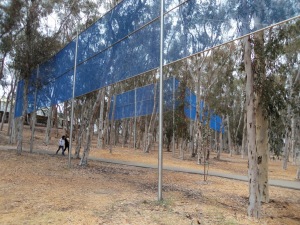 |
| “Two Running Violet V Forms” Installation: Robert Irwin |
What would a trip to San Diego be without some pink flamingoes?
